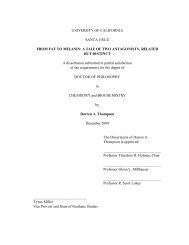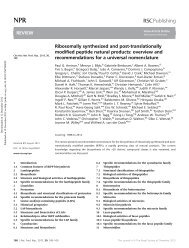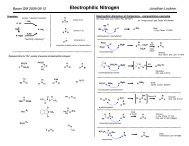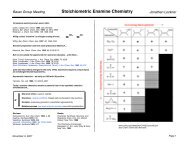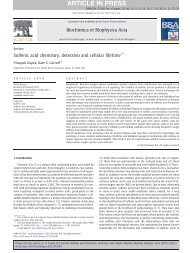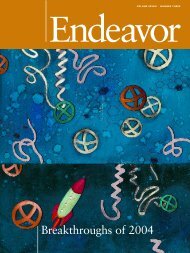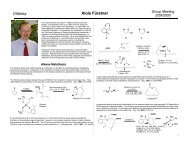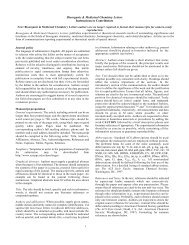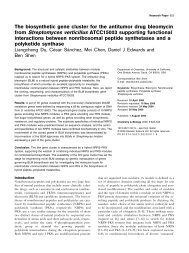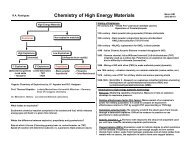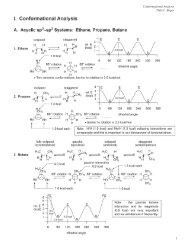Benzothiophene piperazine and piperidine urea ... - ResearchGate
Benzothiophene piperazine and piperidine urea ... - ResearchGate
Benzothiophene piperazine and piperidine urea ... - ResearchGate
Create successful ePaper yourself
Turn your PDF publications into a flip-book with our unique Google optimized e-Paper software.
ARTICLE IN PRESS<br />
Bioorganic & Medicinal Chemistry Letters xxx (2009) xxx–xxx<br />
Contents lists available at ScienceDirect<br />
Bioorganic & Medicinal Chemistry Letters<br />
journal homepage: www.elsevier.com/locate/bmcl<br />
<strong>Benzothiophene</strong> <strong>piperazine</strong> <strong>and</strong> <strong>piperidine</strong> <strong>urea</strong> inhibitors of fatty acid<br />
amide hydrolase (FAAH)<br />
Douglas S. Johnson a,b, *, Kay Ahn a,b , Suzanne Kesten a , Scott E. Lazerwith a , Yuntao Song a , Mark Morris a ,<br />
Lorraine Fay a , Tracy Gregory a,b , Cory Stiff a,b , James B. Dunbar Jr. a , Marya Liimatta a,c , David Beidler a,d ,<br />
Sarah Smith a,d , Tyzoon K. Nomanbhoy e , Benjamin F. Cravatt f<br />
a Pfizer Global Research <strong>and</strong> Development, 2800 Plymouth Road, Ann Arbor, MI 48105, USA<br />
b Pfizer Global Research <strong>and</strong> Development, Eastern Point Road, Groton, CT 06340, USA<br />
c Pfizer Global Research <strong>and</strong> Development, 620 Memorial Drive, Cambridge, MA 02139, USA<br />
d Pfizer Global Research <strong>and</strong> Development, 700 Chesterfield Parkway, Chesterfield, MO 63017, USA<br />
e ActivX Biosciences, 11025 North Torrey Pines Road, La Jolla, CA 92037, USA<br />
f Department of Chemical Physiology, The Skaggs Institute for Chemical Biology, The Scripps Research Institute, 10550 North Torrey Pines Road, La Jolla, CA 92037, USA<br />
article<br />
info<br />
abstract<br />
Article history:<br />
Received 24 February 2009<br />
Revised 16 March 2009<br />
Accepted 20 March 2009<br />
Available online xxxx<br />
Keywords:<br />
FAAH inhibitor<br />
Fatty acid amide hydrolase<br />
Urea<br />
Activity-based protein profiling<br />
Covalent inhibitor<br />
The synthesis <strong>and</strong> structure–activity relationships (SAR) of a series of benzothiophene <strong>piperazine</strong> <strong>and</strong><br />
<strong>piperidine</strong> <strong>urea</strong> FAAH inhibitors is described. These compounds inhibit FAAH by covalently modifying<br />
the enzyme’s active site serine nucleophile. Activity-based protein profiling (ABPP) revealed that these<br />
<strong>urea</strong> inhibitors were completely selective for FAAH relative to other mammalian serine hydrolases. Several<br />
compounds showed in vivo activity in a rat complete Freund’s adjuvant (CFA) model of inflammatory<br />
pain.<br />
Ó 2009 Elsevier Ltd. All rights reserved.<br />
* Corresponding author.<br />
E-mail address: doug.johnson@pfizer.com (D.S. Johnson).<br />
N<br />
H<br />
N<br />
O<br />
O<br />
URB597<br />
PF-750<br />
N<br />
O<br />
O<br />
N<br />
H<br />
NH 2<br />
OL-135<br />
Me<br />
Fatty acid amide hydrolase (FAAH) is an integral membrane enzyme<br />
that degrades the fatty acid amide family of signaling lipids,<br />
including the endocannabinoid an<strong>and</strong>amide. 1 Genetic 1g or pharmacological<br />
1f inactivation of FAAH leads to elevated endogenous<br />
levels of fatty acid amides <strong>and</strong> a range of behavioral effects including<br />
analgesic <strong>and</strong> anti-inflammatory phenotypes in rodents.<br />
Importantly, these behavioral phenotypes occur in the absence of<br />
alterations in motility, weight gain, or body temperature that are<br />
typically observed with direct cannabinoid receptor 1 (CB1) agonists,<br />
indicating that FAAH may represent an attractive therapeutic<br />
target for the treatment of inflammatory pain <strong>and</strong> related conditions.<br />
2 Several classes of FAAH inhibitors have been reported<br />
including electrophilic ketones (e.g., OL-135 3 ), carbamates (e.g.,<br />
URB597 4 <strong>and</strong> SA-47 5 ) <strong>and</strong>, more recently, <strong>piperidine</strong>/<strong>piperazine</strong> <strong>urea</strong>s<br />
(e.g., PF-750 6 <strong>and</strong> Takeda-25/JNJ-1661010 7 )(Fig. 1). We recently<br />
reported that PF-750 inhibits FAAH by covalently<br />
modifying the enzyme’s active site serine nucleophile <strong>and</strong> is completely<br />
selective for FAAH relative to other mammalian serine<br />
hydrolases. 6a In this Letter, we describe the synthesis <strong>and</strong> structure–activity<br />
relationships (SAR) of a series of benzothiophene<br />
<strong>piperazine</strong> <strong>and</strong> <strong>piperidine</strong> <strong>urea</strong> FAAH inhibitors.<br />
A series of <strong>piperazine</strong> phenyl <strong>urea</strong>s, exemplified by 1, was discovered<br />
by high throughput screening of the Pfizer chemical file<br />
O<br />
O<br />
N<br />
N<br />
N<br />
N<br />
N<br />
N S<br />
SA-47<br />
N<br />
N<br />
H<br />
N<br />
O<br />
O<br />
O<br />
N<br />
H<br />
JNJ-1661010/Takeda-25<br />
Figure 1. Structures of FAAH inhibitors.<br />
O<br />
NHMe<br />
0960-894X/$ - see front matter Ó 2009 Elsevier Ltd. All rights reserved.<br />
doi:10.1016/j.bmcl.2009.03.080<br />
Please cite this article in press as: Johnson, D. S.; et al. Bioorg. Med. Chem. Lett. (2009), doi:10.1016/j.bmcl.2009.03.080
ARTICLE IN PRESS<br />
2 D. S. Johnson et al. / Bioorg. Med. Chem. Lett. xxx (2009) xxx–xxx<br />
O<br />
O<br />
N<br />
1<br />
N<br />
O<br />
N<br />
H<br />
against human FAAH (Fig. 2). We prepared <strong>piperazine</strong> phenyl <strong>urea</strong><br />
intermediate 2 <strong>and</strong> performed a series of reductive aminations<br />
with various aromatic aldehydes (Scheme 1, Eqs. 1 <strong>and</strong> 2). This allowed<br />
us to easily vary the aldehyde component <strong>and</strong> resulted in<br />
the identification of several bicyclic cores including PF-622 6a <strong>and</strong><br />
a series of benzothiophenes represented by 4h which is the subject<br />
of this manuscript (Scheme 1, Eq. 2).<br />
We then explored the benzothiophene lead 4h in more detail.<br />
Therefore, the benzothiophene <strong>piperazine</strong> intermediate 5 was prepared<br />
according to equation 3 <strong>and</strong> reacted with various commercially<br />
available alkyl <strong>and</strong> aryl isocyanates or phenyl carbamates<br />
of heterocyclic amines 8 to give the corresponding <strong>piperazine</strong> <strong>urea</strong>s<br />
4 <strong>and</strong> 6 (Scheme 1).<br />
Schemes 2 <strong>and</strong> 3 outline the synthesis of representative <strong>piperidine</strong><br />
<strong>urea</strong> FAAH inhibitors utilized in the current studies. Lithiation<br />
of benzothiophene 7 followed by reaction with Weinreb amide 8<br />
provided ketone 9 in good yield. 9 Ketone 9 was reduced with sodium<br />
borohydride to give alcohol 10 which underwent elimination<br />
when treated with p-toluene sulfonic acid (TsOH). The resulting<br />
double bond was hydrogenated to give <strong>piperidine</strong> 11 which was<br />
treated with isocyanate 12 as described previously to give the desired<br />
<strong>urea</strong> 13. 8<br />
The linker analogs 15–18 were synthesized according to<br />
Scheme 3. Deprotection of Boc-<strong>piperidine</strong> 14 with TFA followed<br />
by reaction with isocyanate 12 afforded <strong>urea</strong> 15 with a ketone linker.<br />
Wittig olefination of ketone 15 provided compound 16 with a<br />
methylene substituted linker. Hydrogenation of the double bond<br />
gave 17 with a methyl substituted linker as the racemate <strong>and</strong> the<br />
enantiomers were separated by chiral chromatography. Furthermore,<br />
ketone 15 was reduced to give racemic 18 with a hydroxy<br />
substituted linker.<br />
As previously reported, these <strong>piperidine</strong>/<strong>piperazine</strong> <strong>urea</strong>s inhibit<br />
FAAH by covalent carbamylation of the catalytic Ser241 nucleophile.<br />
6a,b Therefore, the potency of these benzothiophene<br />
<strong>piperidine</strong>/<strong>piperazine</strong> <strong>urea</strong> inhibitors were determined by the second<br />
order rate constants k inact /K i values using an enzyme-coupled<br />
FAAH assay as described previously. 6b,10 Unlike IC 50 values, k inact /<br />
K i values do not change with various preincubation times <strong>and</strong> have<br />
been described as the best measure of potency for irreversible<br />
inhibitors. 11<br />
Table 1 shows the SAR of the right h<strong>and</strong> portion of the <strong>urea</strong>. The<br />
alkyl <strong>urea</strong>s (4a–g) had very low potency for FAAH, which is similar<br />
N<br />
N<br />
PF-622<br />
Figure 2. Structures of HTS lead (1) <strong>and</strong> PF-622.<br />
N<br />
O<br />
N<br />
H<br />
F<br />
c, d<br />
7<br />
S<br />
F<br />
a<br />
S<br />
11<br />
F<br />
Me<br />
N<br />
MeO<br />
O<br />
8<br />
NH<br />
N Boc<br />
Boc<br />
N b<br />
S<br />
S<br />
9<br />
O<br />
10<br />
e<br />
Boc<br />
N<br />
Scheme 2. Synthesis of <strong>piperidine</strong> <strong>urea</strong> 13: (a) n-BuLi, THF, 78 °C; then add 8, 70%,<br />
(b) NaBH 4 , EtOH, quant; (c) TsOH, toluene, quant; (d) H 2 (g), 20% Pd/C, MeOH, 87%;<br />
(e) 12, CH 2 Cl 2 , 60%.<br />
S<br />
S<br />
O<br />
14<br />
16<br />
Boc<br />
N<br />
N<br />
O<br />
N<br />
H<br />
a, b<br />
N<br />
d<br />
to what has been observed for N-alkyl <strong>urea</strong> analogs of URB597. 4a In<br />
contrast, we found that aryl <strong>urea</strong>s such as phenyl <strong>urea</strong> 4h were potent<br />
FAAH inhibitors. Next, we investigated a series of heteroaromatic<br />
<strong>urea</strong>s (4i–l, 6a) in part to avoid the generation of aniline<br />
upon covalent binding to FAAH. The 3-aminopyridyl group (6a)<br />
was preferred over the 2-aminopyridyl (4i) <strong>and</strong> 3-aminopyridazinyl<br />
(4j) groups in the benzothiophene series. The SAR of the heterocyclic<br />
group was highly sensitive. For example, isoxazole 4k<br />
retained potency, while the potency was lost with methylthiazole<br />
4l, which is consistent with observations made by Keith et al. in a<br />
related thiadiazolopiperazinyl <strong>urea</strong> series. 7b Boger <strong>and</strong> co-workers<br />
also observed that subtle changes in the central heterocycle of a-<br />
ketoheterocycle FAAH inhibitors greatly influence inhibitor activ-<br />
F<br />
F<br />
S<br />
OCN<br />
O<br />
15<br />
12<br />
N<br />
O<br />
13<br />
N<br />
f<br />
N<br />
H<br />
OH<br />
N<br />
N<br />
O<br />
N<br />
O<br />
R<br />
R=Me:17-rac<br />
N<br />
H<br />
N<br />
H<br />
R=Me:17-E1 <strong>and</strong> 17-E2<br />
R=OH:18-rac<br />
Scheme 3. Synthesis of linker analogs 15–18: (a) TFA, CH 2 Cl 2 , 99%; (b) 12, CH 2 Cl 2 ,<br />
85%; (c) Ph 3 PCH 3 Br, n-BuLi, THF, 20 °C to rt, 97%; d) H 2 (g), Pd/C, MeOH, 76%; (e)<br />
chiral chromatography (CHIRALCEL Ò OD); (f) NaBH 4 , EtOH, quant.<br />
S<br />
e<br />
S<br />
c<br />
N<br />
N<br />
N<br />
Boc<br />
NH<br />
a, b<br />
HN<br />
N<br />
2<br />
O<br />
Ph<br />
N<br />
H<br />
RCHO<br />
c<br />
R<br />
N<br />
N<br />
3<br />
O<br />
Ph<br />
N<br />
H<br />
(eq 1)<br />
S<br />
CHO<br />
+<br />
HN<br />
O<br />
Ph<br />
N N c<br />
H<br />
N<br />
S<br />
2 4h<br />
O<br />
Ph<br />
N N<br />
H<br />
(eq 2)<br />
S<br />
CHO<br />
d<br />
S<br />
5<br />
N<br />
NH<br />
eorf<br />
S<br />
N<br />
4 <strong>and</strong> 6<br />
O<br />
R<br />
N N<br />
H<br />
(eq 3)<br />
Scheme 1. Synthesis of <strong>piperazine</strong> <strong>urea</strong>s 4 <strong>and</strong> 6: (a) PhNCO, CH 2 Cl 2 , 92%; (b) TFA, CH 2 Cl 2 , 80–99% (c) NaBH(OAc) 3 , DCE, 50–95%; (d) N-Boc-<strong>piperazine</strong>, NaBH(OAc) 3 ,CH 2 Cl 2 ;<br />
then TFA, CH 2 Cl 2 , 64%; (e) RNCO (R = alkyl, Ph, 3-pyr; ie. 4d–g, 4h, 6a), CH 2 Cl 2 , 50–90%; (f) RNHCO 2 Ph (R = heterocycle, ie. 4j–1, 6), DMSO, 60 °C, 50–80%.<br />
Please cite this article in press as: Johnson, D. S.; et al. Bioorg. Med. Chem. Lett. (2009), doi:10.1016/j.bmcl.2009.03.080
ARTICLE IN PRESS<br />
D. S. Johnson et al. / Bioorg. Med. Chem. Lett. xxx (2009) xxx–xxx 3<br />
Table 1<br />
Human <strong>and</strong> rat FAAH potency (k inact /K i values) 15 for compounds 4a–l, 6a showing SAR<br />
of the right h<strong>and</strong> side of the <strong>urea</strong><br />
ity. 3c Also it is interesting to note that isoxazole 4k exhibited equal<br />
potency for hFAAH <strong>and</strong> rFAAH, while phenyl <strong>urea</strong> 4h <strong>and</strong> pyridazine<br />
<strong>urea</strong> 4j showed higher potency for hFAAH than rFAAH.<br />
Next, we investigated the effect of substituents at the 6-position<br />
of the 3-amino pyridine (Table 2). The compounds with 6-methoxy<br />
(6g), 6-amino (6i) <strong>and</strong> 6-NHAc (6n) substituents are roughly equipotent<br />
to 6a, while the 6-Cl (6d) <strong>and</strong> 6-NHMe (6j) groups result in<br />
compounds that are about twofold less potent <strong>and</strong> the potency is<br />
further diminished by the 6-NHEt (6l) substituent (fourfold less<br />
potent than 6a). Furthermore, 6-CF 3 (6c) <strong>and</strong> 6-NEt 2 (6m) substituents<br />
are detrimental to activity. Taken together with the results in<br />
Table 1, it is clear that the nature of the aromatic amine portion of<br />
the <strong>urea</strong> is critical for activity, but the potency does not appear to<br />
correlate with the leaving group ability. There appears to be a<br />
steric limitation at the 6-position as hFAAH potency generally<br />
decreases with the larger substituents (i.e., h k inact /K i for<br />
NH 2 > NHMe > NMe 2 > NEt 2 ). Interestingly, several 6-amino compounds<br />
(6j–m) actually show a preference for rFAAH over hFAAH.<br />
Table 2<br />
Human <strong>and</strong> rat FAAH potency (k inact /K i values) 15 for compounds 6a–6n showing SAR<br />
of substituted pyridyl <strong>urea</strong>s<br />
S<br />
S<br />
N<br />
N<br />
O<br />
N H<br />
R hk inact /K i (M 1 s 1 ) rk inact /K i (M 1 s 1 )<br />
6a H 2401 1083<br />
6b Me 1481 390<br />
6c CF 3 69
ARTICLE IN PRESS<br />
4 D. S. Johnson et al. / Bioorg. Med. Chem. Lett. xxx (2009) xxx–xxx<br />
fully conjugated <strong>urea</strong><br />
"activated" <strong>urea</strong><br />
S<br />
20<br />
H<br />
N<br />
FAAH binding<br />
- 3-aminopyridine<br />
S<br />
H<br />
δ−<br />
O H<br />
Ser241<br />
N<br />
O H<br />
Ser217<br />
δ+<br />
NH 2<br />
Lys142<br />
S<br />
N<br />
O<br />
O<br />
Ser241<br />
OH<br />
Ser217<br />
NH 2<br />
Lys142<br />
Figure 3. Proposed mechanism of covalent inhibition of FAAH by <strong>piperidine</strong> <strong>urea</strong>s. The catalytic triad Ser-Ser-Lys is shown.<br />
Figure 4. Model of compound 13 covalently attached to Ser241 of h/rFAAH using<br />
coordinates from the PF-750-h/rFAAH crystal structure. 6b Overlay with PF-750<br />
shown in blue.<br />
Figure 5. Model of compound 38 covalently attached to Ser241 of h/rFAAH using<br />
coordinates from the PF-750-h/rFAAH crystal structure. 6b Overlay with PF-750<br />
shown in blue.<br />
We have proposed that the <strong>urea</strong> may be activated upon binding<br />
in the active site of FAAH by undergoing a conformational change<br />
that diminishes conjugation of the nitrogen lone pair with the carbonyl,<br />
which would activate the <strong>urea</strong> toward nucleophile attack as<br />
shown in Figure 3. 6a It appears that a cyclic secondary amine such<br />
as <strong>piperazine</strong> or <strong>piperidine</strong> is critical for activation of the <strong>urea</strong> as<br />
<strong>urea</strong>s prepared from primary amines are ineffective. 4a<br />
Compound 13 (Fig. 4) <strong>and</strong> compound 38 (Fig. 5) were modeled,<br />
12 using Sybyl 8.0, into the ‘humanized’ rat FAAH (h/rFAAH)<br />
crystal structure (2VYA). 6b Compound 13 fit within the binding site<br />
in almost identical fashion to that of PF-750 with only very slight<br />
movement of the surrounding residue atoms, in essence, occupying<br />
virtually identical space. The green surface depicting the binding<br />
site volume <strong>and</strong> the space-filled representations were generated<br />
from the compound 13-h/rFAAH model <strong>and</strong> are virtually identical<br />
to those generated from the PF-750-h/rFAAH crystal structure. In<br />
contrast, when the model of compound 38-h/rFAAH was minimized,<br />
there was a significant shift in the position of the side chain<br />
of Met436. As shown in Figure 5, the ethoxy portion of compound<br />
38 extends beyond the green surface generated from the compound<br />
13 model illustrating the increased size of the lig<strong>and</strong> <strong>and</strong><br />
the subsequent displacement (i.e., push) of the Met436 side chain.<br />
This steric interaction with Met436 could explain the decreased<br />
potency of compound 38.<br />
To assess the selectivity of the benzothiophene <strong>piperidine</strong>/<br />
<strong>piperazine</strong> <strong>urea</strong> series, compounds 6b, 6g (PF-465), <strong>and</strong> 13 (PF-<br />
946) were profiled at 100 lM by competitive activity-based protein<br />
profiling (ABPP) 13 in a number of different proteomes derived<br />
from mouse <strong>and</strong> human sources (Fig. 6). Competitive ABPP provides<br />
a global view of the proteome-wide selectivity of enzyme<br />
inhibitors as described previously. 13b,c In the case of FAAH inhibitors,<br />
we used a reporter-tagged fluorophosphonate (FP) ABPP probe,<br />
13c which serves as a general activity-based profiling tool for the<br />
A. Mouse Liver<br />
Cytosol<br />
2 3 4 5 6<br />
B. Mouse Kidney<br />
Cytosol<br />
1 2 3 4 5 6<br />
C. Human Liver<br />
Cytosol<br />
1 2 3 4 5 6<br />
D. Human Heart<br />
Cytosol<br />
1 1 2 3 4 5 6<br />
E. Human Brain<br />
Membrane<br />
1 2 3 4 5 6<br />
FAAH<br />
MW<br />
80-<br />
66-<br />
45-<br />
42-<br />
Figure 6. Selectivity profiling of FAAH inhibitors. Gel images of proteomes labeled with FP-rhodamine in the absence or presence of FAAH inhibitors (Lane 1, buffer; lane 2, 6b<br />
at 100 lM; lane 3, 6g at 100 lM; lane 4, 13 at 100 lM; lane 5, URB597 at 100 lM; lane 6, URB597 at 10 lM). Inhibited b<strong>and</strong>s are shown with arrows. (A) soluble mouse liver<br />
proteome, (B) soluble mouse kidney proteome, (C) soluble human liver proteome, (D) soluble human heart proteome, <strong>and</strong> (E) human brain membrane proteome. Fluorescent<br />
gel signals shown in grayscale.<br />
Please cite this article in press as: Johnson, D. S.; et al. Bioorg. Med. Chem. Lett. (2009), doi:10.1016/j.bmcl.2009.03.080
ARTICLE IN PRESS<br />
D. S. Johnson et al. / Bioorg. Med. Chem. Lett. xxx (2009) xxx–xxx 5<br />
Paw Withdrawal Threshhold (g)<br />
25<br />
20<br />
15<br />
10<br />
serine hydrolase super family. 13d,e Serine hydrolases that show significant<br />
reductions in FP probe labeling intensity in the presence of<br />
inhibitor are scored as targets of the compound. The selectivity of<br />
compounds 6b, 6g, <strong>and</strong> 13 was compared to that of URB597, which<br />
was profiled at 10 <strong>and</strong> 100 lM. Gel images of soluble proteomes of<br />
mouse liver, mouse kidney, human liver, <strong>and</strong> human heart <strong>and</strong> the<br />
membrane proteome of human brain are shown in Figure 6. Consistent<br />
with previous reports, 6a,14 multiple off-targets were observed<br />
in peripheral tissues for URB597 even at 10 lM,<br />
particularly amongst FP-labeled proteins migrating between 55<br />
<strong>and</strong> 65 kDa. It is noteworthy that URB597, which has been shown<br />
to be highly selective for serine hydrolases in mouse brain proteomes,<br />
inhibits at least one additional hydrolase migrating at 55–<br />
60 kDa in the human brain membrane proteome. In contrast, no<br />
off-targets were observed for compounds 6b, 6g, <strong>and</strong> 13 even when<br />
tested at 100 lM (Fig. 6). Under the assay conditions, compounds<br />
6b, 6g, 13, <strong>and</strong> URB597 completely inhibited FAAH from both<br />
mouse <strong>and</strong> human tissues.<br />
Next we selected compound 6g (PF-465) to assess its in vivo<br />
efficacy in a rat model of inflammatory pain. Subcutaneous injection<br />
of complete Freund’s adjuvant (CFA) into the plantar surface<br />
of the hind paw produced a significant decrease in mechanical<br />
paw weight threshold (PWT) at 5 days post injection (Fig. 7). Compound<br />
6g dosed at 3, 10 <strong>and</strong> 30 mg/kg (ip) caused a dose-dependent<br />
inhibition of mechanical allodynia with a minimum<br />
effective dose (MED) of 10 mg/kg. At doses of 10 <strong>and</strong> 30 mg/kg,<br />
compound 6g inhibited pain responses to an equivalent degree<br />
as the nonsteroidal anti-inflammatory drug naproxen (10 mg/kg,<br />
ip).<br />
In conclusion, we have described a series of benzothiophene<br />
<strong>piperazine</strong>/<strong>piperidine</strong> <strong>urea</strong> FAAH inhibitors that covalently modify<br />
the enzyme’s active site serine nucleophile. Activity-based protein<br />
profiling revealed that these <strong>urea</strong> inhibitors are highly selective for<br />
FAAH relative to other mammalian serine hydrolases. Furthermore,<br />
in vivo activity was demonstrated in a rat CFA model of inflammatory<br />
pain. Additional SAR development of this class of <strong>piperazine</strong>/<br />
<strong>piperidine</strong> <strong>urea</strong> FAAH inhibitors will be reported in due course.<br />
References <strong>and</strong> notes<br />
5<br />
0<br />
Naive Vehicle 3 10 30 Naproxen<br />
[Compound 6g] (mg/kg, i.p.)<br />
1. (a) Cravatt, B. F.; Giang, D. K.; Mayfield, S. P.; Boger, D. L.; Lerner, R. A.; Gilula, N.<br />
B. Nature 1996, 384, 83; (b) Bracey, M. A.; Hanson, M. A.; Masuda, K. R.; Stevens,<br />
*<br />
* *<br />
Figure 7. Anti-hyperalgesic effects of compound 6g (3–30 mg/kg, ip) in the CFA<br />
model of inflammatory pain. Compound 6g produces a dose-dependent reduction<br />
of mechanical allodynia (hyperalgesic) in rats (black bars). The effect of the nonsteroidal<br />
anti-inflammatory drug naproxen (10 mg/kg, ip hatched bar) is shown for<br />
comparison. Anti-hyperalgesic responses were determined at 4 h following drug<br />
treatment <strong>and</strong> were significantly different between compound 6g- <strong>and</strong> vehicletreated<br />
groups (p < 0.05). n = 8 rats/group.<br />
R. C.; Cravatt, B. F. Science 2002, 298, 1793; (c) Cravatt, B. F.; Lichtman, A. H.<br />
Curr. Opin. Chem. Biol. 2003, 7, 469; (d) McKinney, M. K.; Cravatt, B. F. Annu. Rev.<br />
Biochem. 2005, 74, 411; (e) Ahn, K.; McKinney, M. K.; Cravatt, B. F. Chem. Rev.<br />
2008, 108, 1687; (f) Cravatt, B. F.; Demarest, K.; Patricelli, M. P.; Bracey, M. H.;<br />
Giang, D. K.; Martin, B. R.; Lichtman, A. H. Proc. Natl. Acad. Sci. U.S.A. 2001, 98,<br />
9371; (g) Kathuria, S.; Gaetani, S.; Fegley, D.; Valino, F.; Duranti, A.; Tontini, A.;<br />
Mor, M.; Tarzia, G.; La Rana, G.; Calignano, A.; Giustino, A.; Tattoli, M.; Palmery,<br />
M.; Cuomo, V.; Piomelli, D. Nat. Med. 2003, 9, 76.<br />
2. (a) Lambert, D. M.; Fowler, C. J. J. Med. Chem. 2005, 48, 5059; (b) Pacher, P.;<br />
Batkai, S.; Kunos, G. Pharmacol. Rev. 2006, 58, 389; (c) Di Marzo, V. Nat. Rev.<br />
Drug Disc. 2008, 7, 438; (d) Seierstad, M.; Breitenbucher, J. G. J. Med. Chem.<br />
2008, 51, 7327.<br />
3. (a) Boger, D. L.; Sato, H.; Lerner, A. E.; Hedrick, M. P.; Fecik, R. A.; Miyauchi, H.;<br />
Wilkie, G. D.; Austin, B. J.; Patricelli, M. P.; Cravatt, B. F. Proc. Natl. Acad. Sci.<br />
U.S.A. 2000, 97, 5044; (b) Boger, D. L.; Miyauchi, H.; Du, W.; Hardouin, C.; Fecik,<br />
R. A.; Cheng, H.; Hwang, I.; Hedrick, M. P.; Leung, D.; Acevedo, O.; Guimaraes, C.<br />
R. W.; Jorgensen, W. L.; Cravatt, B. F. J. Med. Chem. 2005, 48, 1849; (c) Garfunkle,<br />
J.; Ezzili, C.; Rayl, T. J.; Hochstatter, D. G.; Hwang, I.; Boger, D. L. J. Med. Chem.<br />
2008, 51, 4392.<br />
4. (a) Tarzia, G.; Duranti, A.; Tontini, A.; Piersanti, G.; Mor, M.; Rivara, S.; Plazzi, P.<br />
V.; Park, C.; Kathuria, S.; Piomelli, D. J. Med. Chem. 2003, 46, 2352; (b) Mor, M.;<br />
Rivara, S.; Lodola, A.; Plazzi, P. V.; Tarzia, G.; Duranti, A.; Tontini, A.; Piersanti,<br />
G.; Kathuria, S.; Piomelli, D. J. Med. Chem. 2004, 47, 4998; (c) Tarzia, G.; Duranti,<br />
A.; Gatti, G.; Piersanti, G.; Tontini, A.; Rivara, S.; Lodola, A.; Plazzi, P. V.; Mor, M.;<br />
Kathuria, S.; Piomelli, D. Chem. Med. Chem. 2006, 1, 2352.<br />
5. Abouab-Dellah, A.; Burnier, P.; Hoornaert, C.; Jeunesse, J.; Puech, F. Patent WO<br />
2004/099176, 2004; US 2006/0089344, 2006.<br />
6. (a) Ahn, K.; Johnson, D. S.; Fitzgerald, L. R.; Liimatta, M.; Arendse, A.; Stevenson,<br />
T.; Lund, E. T.; Nugent, R. A.; Nomanbhoy, T. K.; Alex<strong>and</strong>er, J. P.; Cravatt, B. F.<br />
Biochemistry 2007, 46, 13019; (b) Mileni, M.; Johnson, D. S.; Wang, Z.; Everdeen,<br />
D.; Liimatta, M.; Pabst, B.; Bhattacharya, K.; Nugent, R. A.; Kamtekar, S.; Cravatt,<br />
B. F.; Ahn, K.; Stevens, R. C. Proc. Natl. Acad. Sci. U.S.A. 2008, 105, 12820; (c)<br />
Apodaca, R; Breitenbucher, J. G.; Pattabiraman, K.; Seierstad, M.; Xiao, W.<br />
Patent WO 2006/074025, 2006.<br />
7. (a) Matsumoto, T.; Kori, M.; Miyazaki, J.; Kiyota, Y. Patent WO 2006/054652,<br />
2006; EP 1813606, 2007.; (b) Keith, J. M.; Apodaca, R.; Xiao, W.; Seierstad, M.;<br />
Pattabiraman, K.; Wu, J.; Webb, M.; Karbarz, M. J.; Brown, S.; Wilson, S.; Scott,<br />
B.; Tham, C.-S.; Luo, L.; Palmer, J.; Wennerholm, M.; Chaplan, S.; Breitenbucher,<br />
J. G. Bioorg. Med. Chem. Lett. 2008, 18, 4838; (c) Karbarz, M. J.; Luo, L.; Chang, L.;<br />
Tham, C.-S.; Palmer, J. A.; Wilson, S. J.; Wennerholm, M. L.; Brown, S. M.; Scott,<br />
B. P.; Apodaca, R. L.; Keith, J. M.; Wu, J.; Breitenbucher, J. G.; Chaplan, S. R.;<br />
Webb, M. Anesthesia Analgesia 2009, 108, 316.<br />
8. (a) Thavonekham, B. Synthesis 1997, 1189; (b) Swanson, D. M.; Dubin, A. E.;<br />
Shah, C.; Nasser, N.; Chang, L.; Dax, S. L.; Jetter, M.; Breitenbucher, J. G.; Liu, C.;<br />
Mazur, C.; Lord, B.; Gonzales, L.; Hoey, K.; Rizzolio, M.; Bogenstaetter, M.; Codd,<br />
E. E.; Lee, D. H.; Zhang, S.-P.; Chaplan, S. R.; Carruthers, N. I. J. Med. Chem. 2005,<br />
48, 1857.<br />
9. Matsunaga, N.; Kaku, T.; Itoh, F.; Tanaka, T.; Hara, T.; Miki, H.; Iwasaki, M.;<br />
Aono, T.; Yamaoka, M.; Kusaka, M.; Tasaka, A. Bioorg. Med. Chem. 2004, 12,<br />
2251.<br />
10. Ahn, K. Patent WO 2006/085196, 2006.<br />
11. Copel<strong>and</strong>, R. A. Enzymes: A Practical Introduction to Structure, Mechanism, <strong>and</strong><br />
Data Analysis, 2nd ed.; Wiley-VCH: New York, 2000. pp 318–349.<br />
12. All the hydrogens were added to the protein <strong>and</strong> each compound was<br />
covalently attached to the sidechain oxygen of Ser241. The protein/lig<strong>and</strong><br />
structures were then minimized using the Sybyl forcefield with the backbone<br />
atoms held constant; charges were not used. These minimized structures were<br />
then compared to the PF-750-h/rFAAH crystal structure.<br />
13. (a) Cravatt, B. F.; Wright, A. T.; Kozarich, J. W. Annu. Rev. Biochem. 2008, 77, 383;<br />
(b) Kidd, D.; Liu, Y.; Cravatt, B. F. Biochemistry 2001, 40, 4005; (c) Leung, D.;<br />
Hardouin, C.; Boger, D. L.; Cravatt, B. F. Nat. Biotechnol. 2003, 21, 687; (d)<br />
Patricelli, M. P.; Giang, D. K.; Stamp, L. M.; Burbaum, J. J. Proteomics 2001, 1,<br />
1067; (e) Liu, Y.; Patricelli, M. P.; Cravatt, B. F. Proc. Natl. Acad. Sci. U.S.A. 1999,<br />
96, 14694.<br />
14. (a) Alex<strong>and</strong>er, J. P.; Cravatt, B. F. Chem. Biol. 2005, 12, 1179; (b) Zhang, D.; Saraf,<br />
A.; Kolasa, T.; Bhatia, P.; Zheng, G. Z.; Patel, M.; Lannoye, G. S.; Richardson, P.;<br />
Stewart, A.; Rogers, J. C.; Brioni, J. D.; Surowy, C. S. Neuropharmacol. 2007, 52,<br />
1095.<br />
15. The hFAAH (amino acids 32–579) <strong>and</strong> rFAAH (amino acids 30–579) constructs<br />
were generated as the N-terminal transmembrane-deleted truncated forms<br />
with N-terminal His 6 tags, <strong>and</strong> were expressed in E. coli <strong>and</strong> purified as<br />
previously described. 6b Both hFAAH <strong>and</strong> rFAAH enzymes used in the present<br />
study had purity greater than 95% based on SDS–PAGE visualized by Coomassie<br />
blue staining. The GDH-coupled FAAH assay was performed for determination<br />
of potencies (k inact /K i values) of inhibitors in 384-well microplates with a final<br />
volume of 50 lL. The details on the assay <strong>and</strong> derivations of the overall<br />
potency, k inact /K i value, have been described previously. 6b In the 384-well<br />
format assay, the k inact /K i values were generally calculated from the slope,<br />
k inact /[K i (1 + [S]/K m )], which is obtained from the k obs versus [I] linear lines. The<br />
k inact /K i values are averages of at least two independent experiments.<br />
Please cite this article in press as: Johnson, D. S.; et al. Bioorg. Med. Chem. Lett. (2009), doi:10.1016/j.bmcl.2009.03.080



